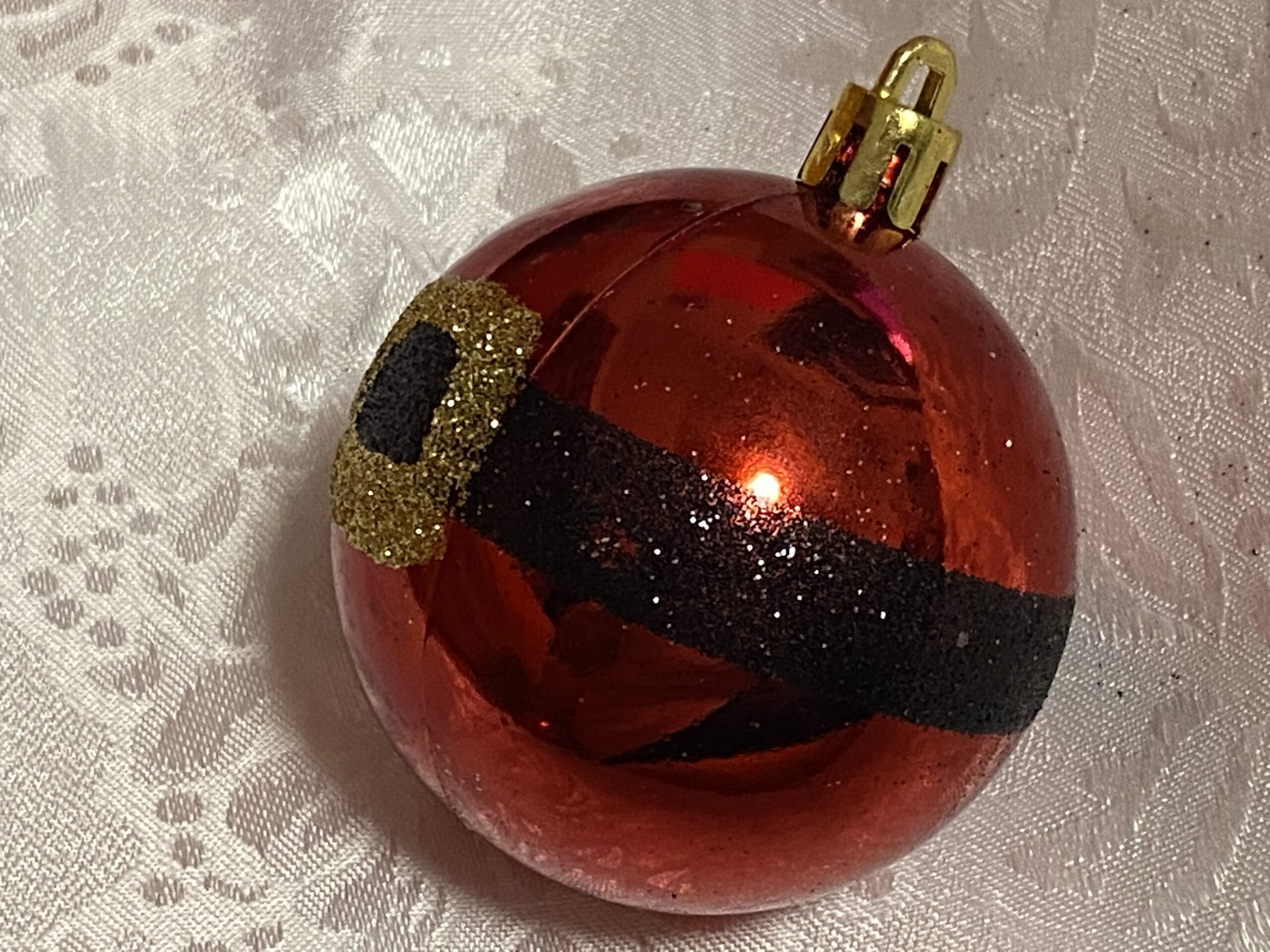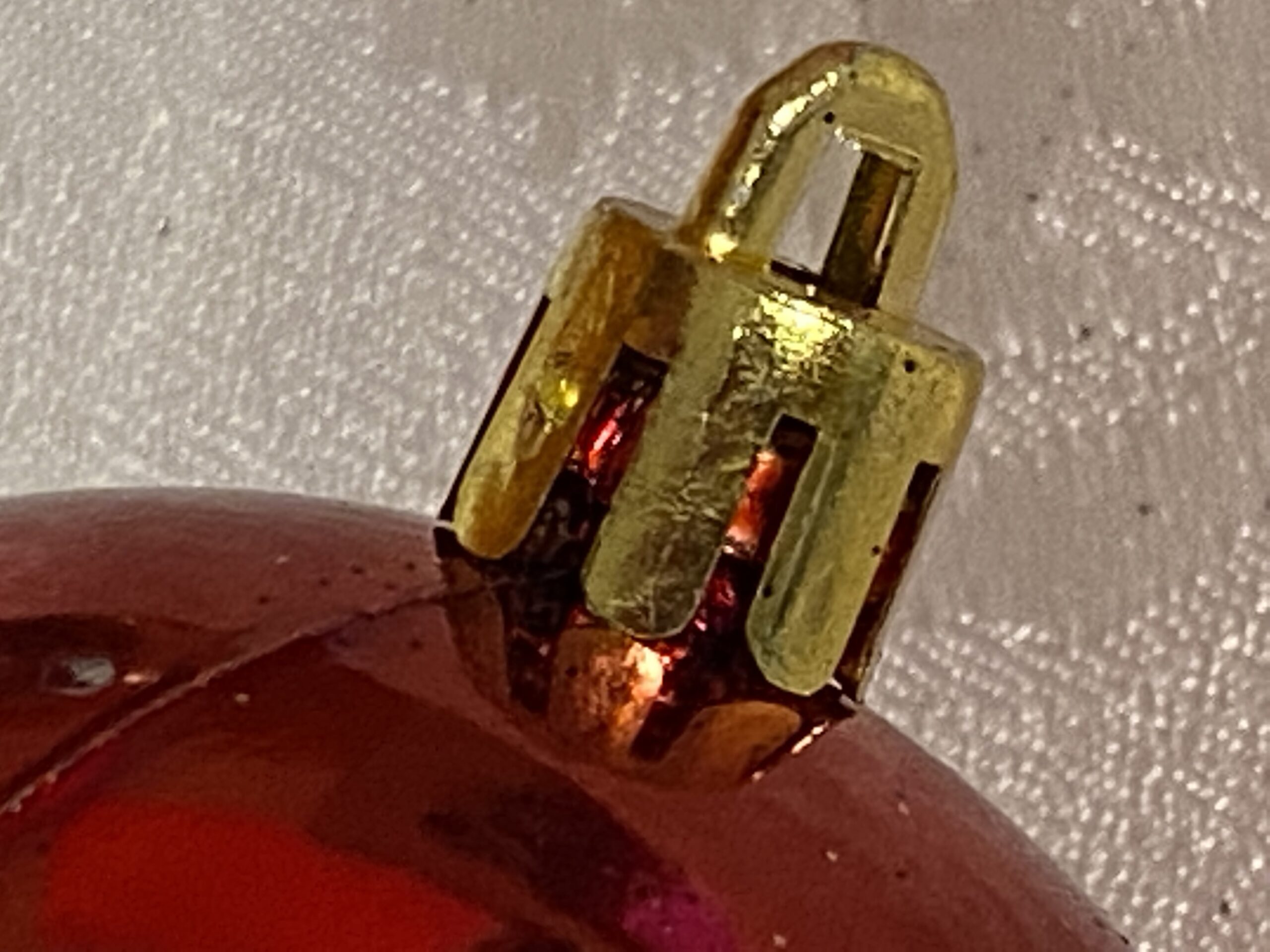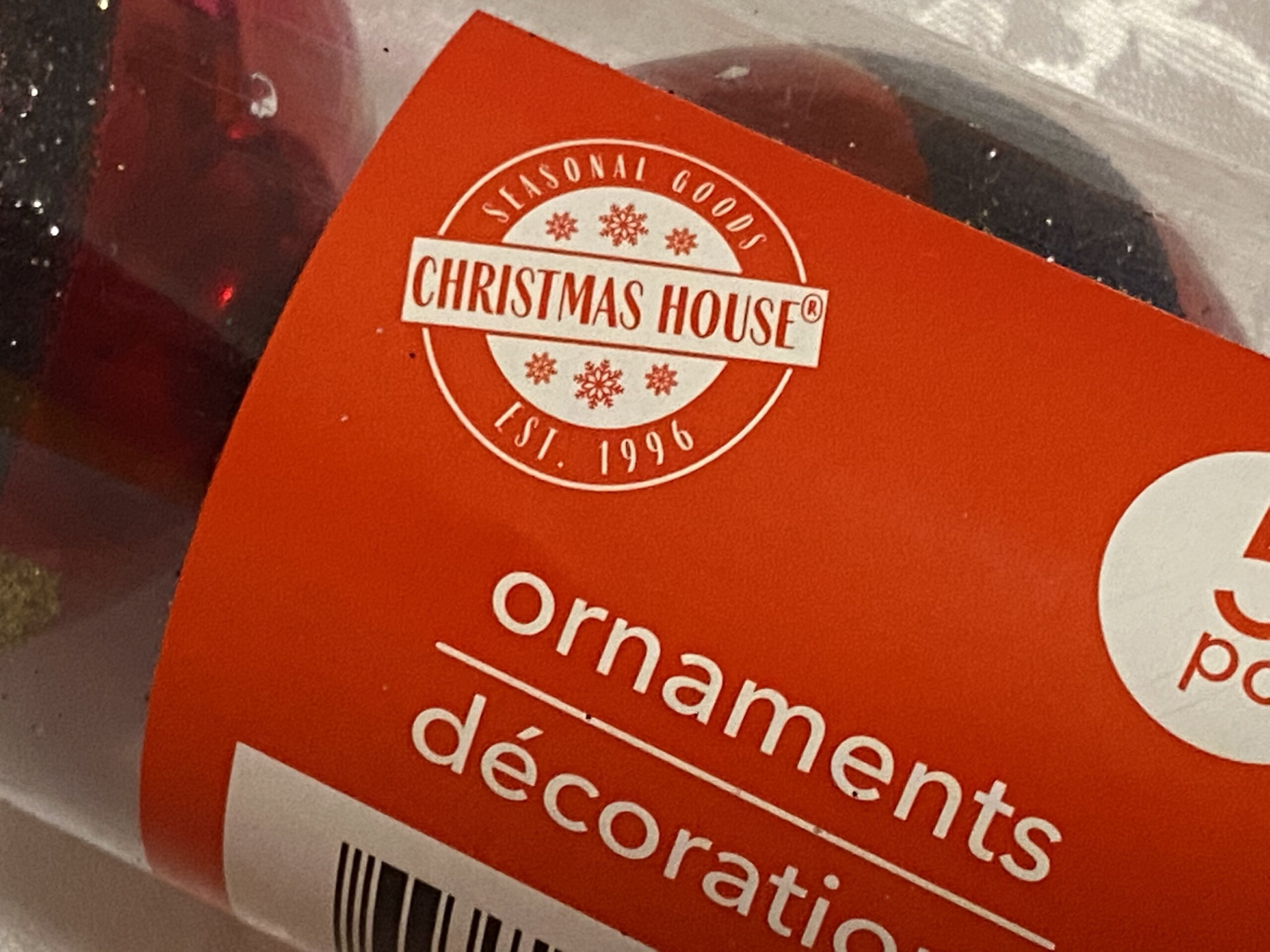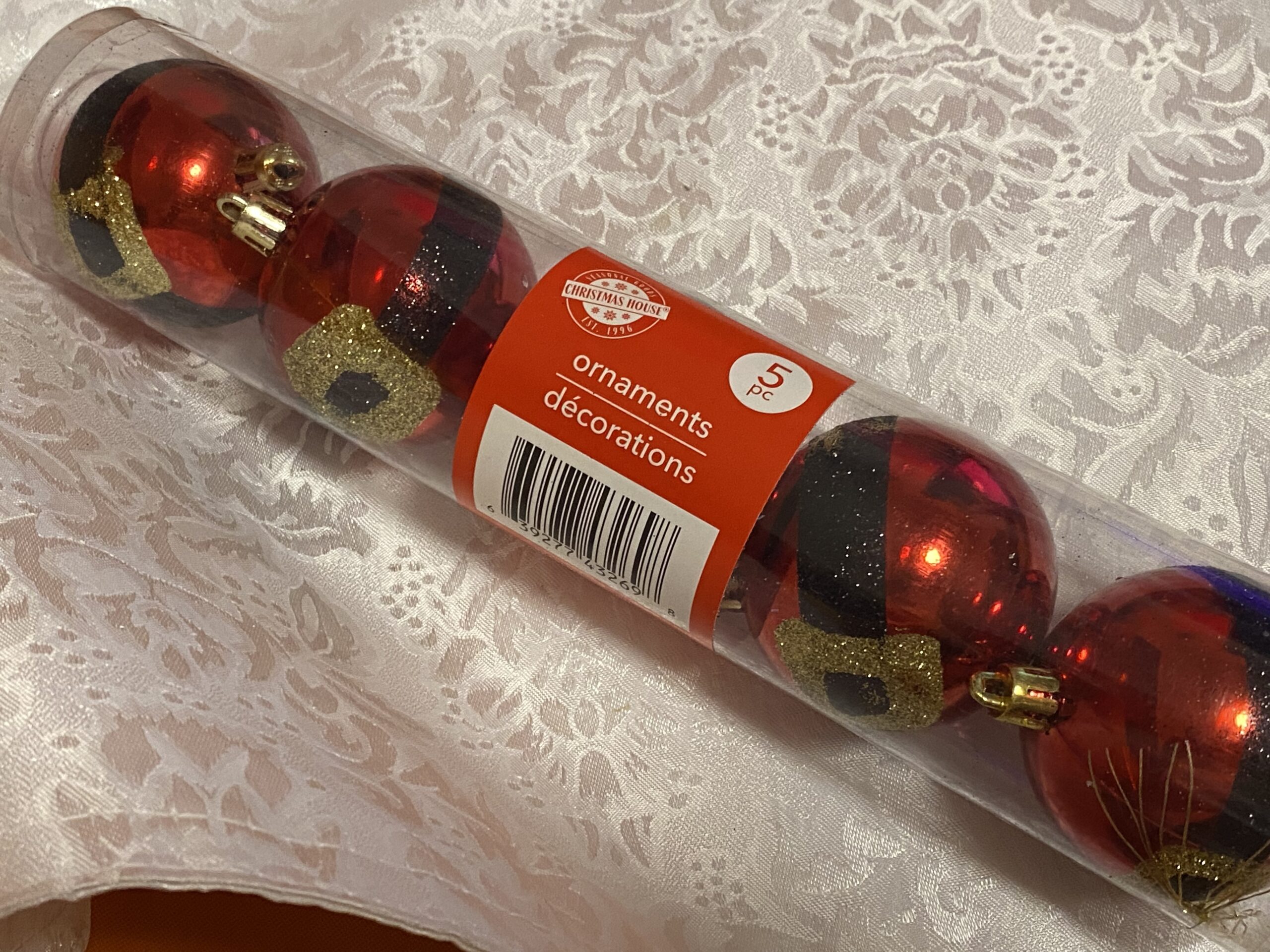Greenbrier International Christmas House (Dollar Tree) 2021 Plastic Tube Ornament (Santa belt design): Positive for Lead, Arsenic, & Antimony
For those new to this website:
Tamara Rubin is a multiple-federal-award-winning independent advocate for childhood Lead poisoning prevention and consumer goods safety, and a documentary filmmaker. She is also a mother of Lead-poisoned children (two of her sons were acutely Lead-poisoned in 2005). Since 2009, Tamara has been using XRF technology (a scientific method used by the U.S. Consumer Product Safety Commission) to test consumer goods for toxicants (specifically heavy metals — including Lead, Cadmium, Mercury, Antimony, and Arsenic). Tamara’s work was featured in Consumer Reports Magazine in February 2023 (March 2023 print edition).
Reading #1) On red plastic of the ball
30-second reading
- Lead (Pb): 32 +/- 8 ppm
- Cadmium (Cd): non-detect
- Mercury (Hg): non-detect
- Bromine (Br): 10,200 +/- 100 ppm
- Chromium (Cr): 296 +/- 39 ppm
- Vanadium (V): 247 +/- 105 ppm
- Iron (Fe): 314 +/- 24 ppm
- Nickel (Ni): 23 +/- 10 ppm
- Copper (Cu): 17 +/- 10 ppm
- Zinc (Zn): 336 +/- 12 ppm
- Arsenic (As): 93 +/- 5 ppm
- Titanium (Ti): 2,785 +/- 185 ppm
- Tin (Sn): 23 +/- 10 ppm
- Antimony (Sb): 1,795 +/- 32 ppm
- Barium (Ba): 316 +/- 58 ppm
- No other metals were detected in consumer goods mode.
Reading #2) On the black glitter of the belt
30-second reading
- Lead (Pb): 35 +/- 9 ppm
- Cadmium (Cd): non-detect
- Mercury (Hg): non-detect
- Bromine (Br): 8,812 +/- 111
- Chromium (Cr): 692 +/- 62 ppm
- Vanadium (V): 324 +/- 132 ppm
- Iron (Fe): 366 +/- 32 ppm
- Nickel (Ni): 24 +/- 13 ppm
- Copper (Cu): 34 +/- 14 ppm
- Zinc (Zn): 300 +/- 14 ppm
- Arsenic (As): 77 +/- 6 ppm
- Titanium (Ti): 3,061 +/- 233 ppm
- Antimony (Sb): 1,476 +/- 35 ppm
- Barium (Ba): 226 +/- 73 ppm
- No other metals were detected in consumer goods mode.
Reading #3) On gold glitter of the belt
30-second reading
- Lead (Pb): 30 +/- 8 ppm
- Cadmium (Cd): non-detect
- Mercury (Hg): non-detect
- Bromine (Br): 8,636 +/- 99
- Chromium (Cr): 369 +/- 46 ppm
- Vanadium (V): 271 +/- 116 ppm
- Iron (Fe): 302 +/- 27 ppm
- Copper (Cu): 23 +/- 12 ppm
- Zinc (Zn): 306 +/- 13 ppm
- Arsenic (As): 77 +/- 6 ppm – same as black.
- Titanium (Ti): 2,409 +/- 198 ppm
- Antimony (Sb): 1,507 +/- 32 ppm
- Barium (Ba): 259 +/- 66 ppm
- No other metals detected in consumer goods mode.
Reading #4) On golden plastic cap
30-second reading
- Lead (Pb): 30 +/- 5 ppm
- Cadmium (Cd): non-detect
- Mercury (Hg): non-detect
- Bromine (Br): 1,697 +/- 20
- Chromium (Cr): non-detect
- Iron (Fe): 733 +/- 35 ppm
- Copper (Cu): 39 +/- 9 ppm
- Zinc (Zn): 123 +/- 8 ppm
- Arsenic (As): 13 +/- 4 ppm
- Titanium (Ti): 713 +/- 188 ppm
- Antimony (Sb): 905 +/- 24 ppm
- Barium (Ba): 655 +/- 87 ppm
- No other metals were detected in consumer goods mode.
Main Takeaway:
“Christmas” does not equal
“intended for use by kids.”
The most important thing to remember when decorating your home for the holidays is that most Christmas decor (and other holiday decor, too!) is — from a manufacturing and regulatory perspective — classified as “not intended for use by children.” (!) This is true for both vintage and new items! This means they are exempt from much (if not all) of the regulatory protections that limit toxicants in items classified as “intended for use by children.”
Christmas items are not toys
While many Christmas items may LOOK like toys (or may look like something a child would play with — and are therefore very attractive to children) they are simply NOT toys.
- Painted items: Many Christmas decor items (including ornaments — especially wood, glass or metal ornaments, both antique or new) are painted with Lead-containing paint. Or (if they are red), with high–Cadmium-content paint or glaze. Cadmium is a known carcinogen — you can read more about Cadmium at this link.
- Plastic: Plastics, including many ornaments that go on the tree (such as plastic decorative ball ornaments) or other plastic electric items (specifically items that plug in, like a pre-lit artificial Christmas tree) are likely to either be high in Lead (which causes brain damage in young children) or to have high levels of Antimony (which is known to cause cancer in rats) since one or both have been applied as flame retardants to these types of products.
- Metal: Pewter or other solid metal ornaments can be made with unsafe levels of Lead (as is true with most heavy shiny yellow Leaded brass) or unsafe levels of Antimony. Vintage or antique pewter items are generally very high Lead. Newer pewter items tend to be high in Antimony. Functional items made of pewter (like decorative serving trays or tea sets) should NEVER be considered safe for food use, BTW. Most pewter that is marked “Lead-free” still actually has unsafe levels of Lead — even if Lead is no longer a main constituent in the substrate of the item! (And in most cases, the bulk of the “missing” Lead in so-called “Lead-free” pewter has been replaced with Antimony — which can be just as toxic, if not more so!)
- Christmas Trees: Artificial Christmas trees are generally either high in Lead or high in Antimony as well. The California “Prop 65” warnings that come with many of these items are NOT a “CYA” (Cover Your Ass) warning “just put there by the manufacturer just to be safe!” They are legitimate warning labels — because these products legally contain toxic chemicals (mostly applied or integrated into the product to comply with flammability regulations).
- Vintage Ceramics: Vintage ceramics designed for the holidays (especially vintage Christmas mugs) are not generally safe for food use and should NOT be given to children (like with hot cocoa) — unless they have specifically been tested and have been shown to be both Lead-free and non-leaching (of any toxic chemicals).
- New Ceramics: New holiday ceramics can also be high-Lead (although they may or may not be leaching when new). In fact, many new Christmas ceramic items (like decorative trays and bowls and platters) actually may never have been leach-tested — because they are considered to be “decor” and not functional food use items (even though the practical application of these items may indeed be for food).
- Twinkly lights: Plug-in holiday string lights generally have high levels of either Lead or Antimony in the cords and bulb holders. This goes for both new and vintage/ older light strings as well as plug-in trees and other plug-in holiday decor items. Based on the testing I have done, older light strings are more likely to have unsafe levels of Lead and newer light strings are more likely to have high (potentially unsafe) levels of Antimony.
As a result, most Christmas items (including brand new Christmas china and ornaments) can LEGALLY have unsafe levels of XRF-detectable heavy metals including (but not limited to) Arsenic, Lead, Cadmium, Antimony, and even Mercury! Please read my full overview article on the subject (which also includes tips for making safer choices for your family) at this link. Thank you!
Some additional Christmas related info for you to explore here on the Lead Safe Mama website:
- Christmas: https://tamararubin.com/category/christmas/
- Artificial Christmas Trees: https://tamararubin.com/category/artificial-christmas-tree/
- Christmas Ornaments: https://tamararubin.com/category/christmas-ornaments/
- Christmas Mugs: https://tamararubin.com/category/christmas-mugs/
- Christmas China: https://tamararubin.com/category/christmas-china/
- Christmas Decorations: https://tamararubin.com/category/christmas-decoration/
- Santa: https://tamararubin.com/category/santa/
Thank you for reading and for sharing this work. Please explore the links above for more information about concerns around Christmas-centric consumer good.
Tamara Elise Rubin
#LeadSafeMama
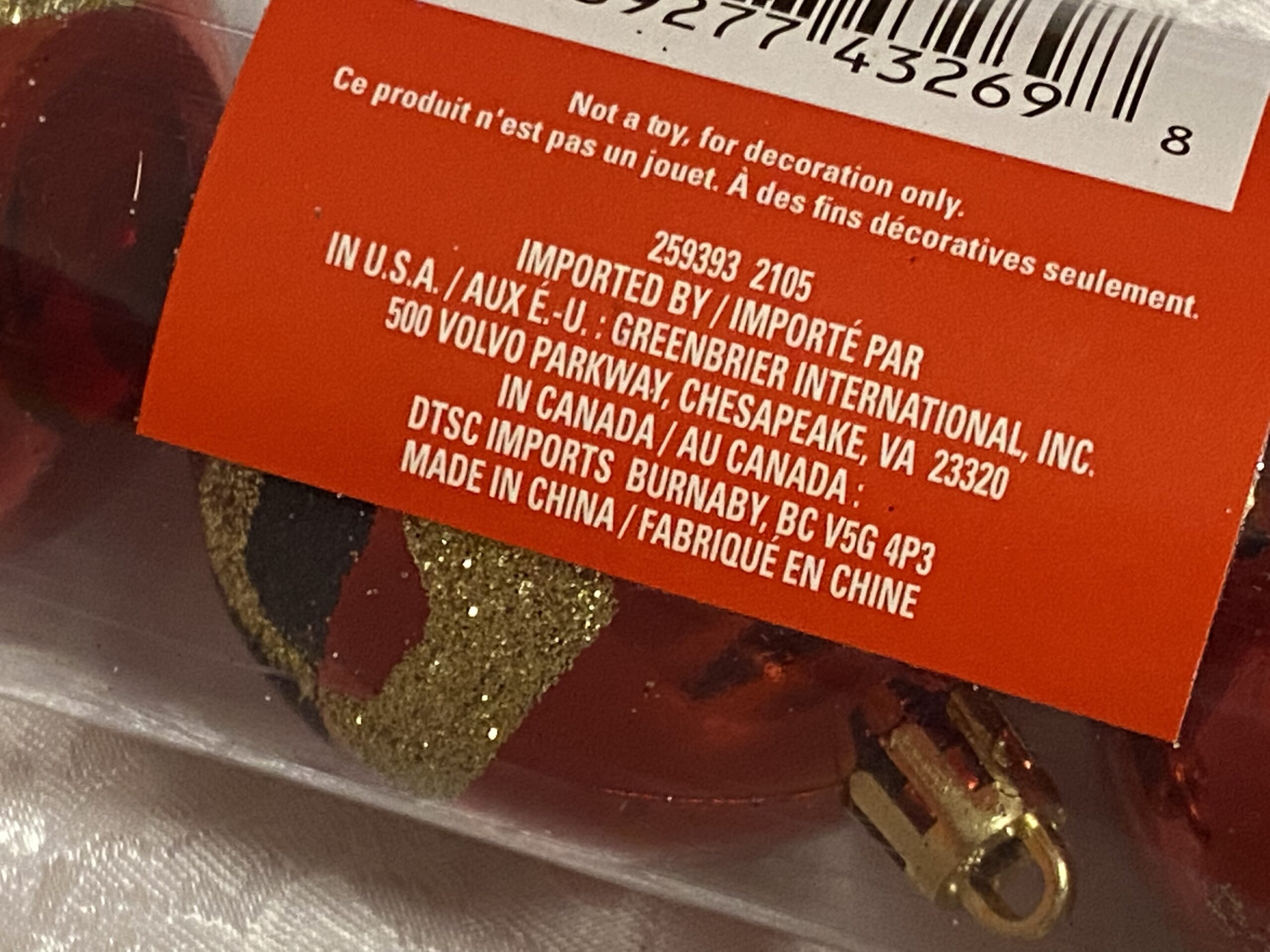

Never Miss an Important Article Again!
Join our Email List








